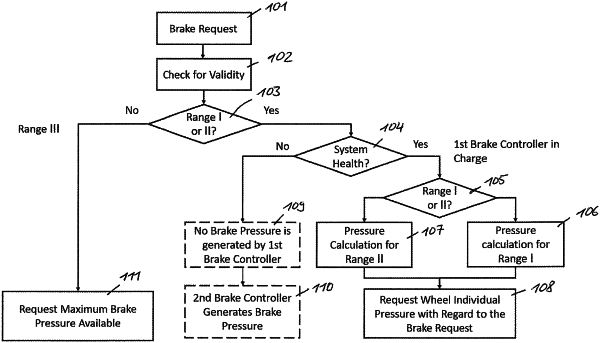| CPC B60T 8/94 (2013.01) [B60T 8/321 (2013.01); B60T 13/683 (2013.01); B60T 17/221 (2013.01); B60T 7/12 (2013.01); B60T 2201/03 (2013.01); B60T 2270/402 (2013.01); B60T 2270/406 (2013.01)] | 15 Claims |

|
1. A method for defining at least one characteristic curve which, in a pressure-actuated brake system of a vehicle, represents a relationship between a brake pressure and a brake demand, the method comprising:
a) specifying a brake demand value range for the brake demand, which includes a minimum brake demand, a maximum brake demand, and intermediate values between the minimum brake demand and the maximum brake demand,
b) specifying a brake pressure value range for the brake pressure, which includes a minimum brake pressure, a maximum brake pressure and intermediate values between the minimum brake pressure and the maximum brake pressure,
c) defining at least two characteristic curve sections of the characteristic curve, by:
c1) defining a first support point of the characteristic curve, at which a first brake demand limit value and a first brake pressure are assigned to one another, the first brake demand limit value lying within the brake demand value range and the first brake pressure lying within the brake pressure value range, and the first brake demand limit value representing a minimum brake demand and the first brake pressure representing a minimum brake pressure,
c2) defining a second support point of the characteristic curve, at which a second brake demand limit value and a second brake pressure are associated with each other, wherein the second brake demand limit value lies within the brake demand value range and is greater in amount than the amount of the minimum brake demand but smaller than the amount of the maximum brake demand, and wherein the second brake pressure is within the brake pressure value range and is greater than the minimum brake pressure but less than the maximum brake pressure,
c2) defining a first characteristic curve section of the characteristic curve which extends between the first support point and the second support point and which, in a first brake demand range, represents the relationship between the brake pressure and the brake demand,
c3) defining a third support point of the characteristic curve, at which a third brake demand limit value and a third brake pressure are associated with each other, wherein the third brake demand limit value lies within the brake demand value range and is greater in amount than the amount of the second brake demand limit value but less than or equal to the amount of the maximum brake demand, and wherein the third brake pressure lies within the brake pressure value range and is equal to the maximum brake pressure,
c4) defining a second characteristic curve section of the characteristic curve which extends between the second support point and the third support point and which, in a second brake demand range, represents the relationship between the brake pressure and a brake demand;
wherein the brake system includes at least two independent electronic brake control units, a first electronic brake control unit and a second electronic brake control unit, and at least one solenoid valve device controlled independently by the first electronic brake control unit and/or the second electronic brake control unit, wherein the characteristic curve is implemented in the first electronic brake control unit and/or in the second electronic brake control unit, and wherein the braking demand is input into the first electronic brake control unit and/or into the second electronic brake control unit, and wherein the first electronic brake control unit and/or the second electronic brake control unit electrically actuate the at least one solenoid valve device independently of one another as a function of the brake demand, to generate the brake pressure.
|